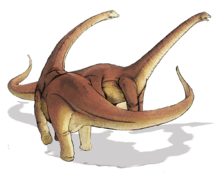Opisthocoelicaudiinae
From Wikipedia, the free encyclopedia
| Opisthocoelicaudiines Temporal range: Late Cretaceous | |
|---|---|
 | |
| Alamosaurus herd | |
| Scientific classification | |
| Kingdom: | Animalia |
| Phylum: | Chordata |
| Clade: | Dinosauria |
| Suborder: | †Sauropodomorpha |
| Clade: | †Titanosauria |
| Family: | †Saltasauridae |
| Subfamily: | †Opisthocoelicaudiinae McIntosh, 1990 |
| Genera | |
| |

Opisthocoelicaudia skeleton restoration in Poland.

Two Alamosaurus sanjuanensis.
The Opisthocoelicaudiinae is a clade of titanosaurian dinosaurs from the Late Cretaceous, ranked as a subfamily. Opisthocoelicaudiines are known from China, Mongolia, and the United States (New Mexico, Texas, and Utah).[1] Three genera have been assigned to Opisthocoelicaudiinae: Alamosaurus, Borealosaurus, and Opisthocoelicaudia (the type genus).[3] It was named by John S. McIntosh in 1990.[1] The hands of opisthocoelicaudiines lacked wrist bones and phalanges.[4]
References
- ↑ 1.0 1.1 1.2 1.3 The Paleobiology Database: Opisthocoelicaudiinae
- ↑ The Paleobiology Database: Borealosaurus
- ↑ González Riga, Bernardo J.; Previtera, Elena; and Pirrone, Cecilia A. (2009). "Malarguesaurus florenciae gen. et sp. nov., a new titanosauriform (Dinosauria, Sauropoda) from the Upper Cretaceous of Mendoza, Argentina". Cretaceous Research 30 (1): 135–148. doi:10.1016/j.cretres.2008.06.006.
- ↑ Tidwell, Virginia; Carpenter, Kenneth (2005). Thunder-Lizards: The Sauropodomorph Dinosaurs. Bloomington, Indiana: Indiana University Press. p. 339. ISBN 0-253-34542-1. Retrieved April 6, 2010.
This article is issued from Wikipedia. The text is available under the Creative Commons Attribution/Share Alike; additional terms may apply for the media files.